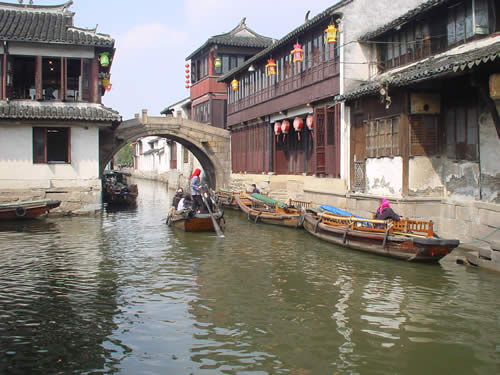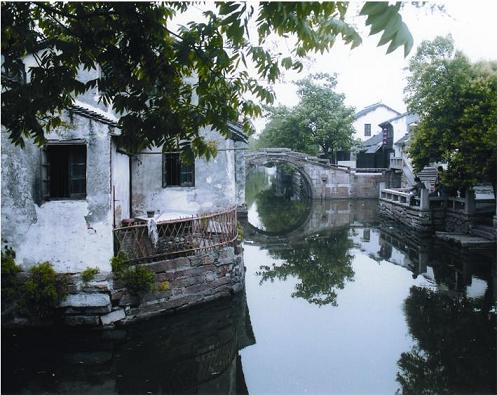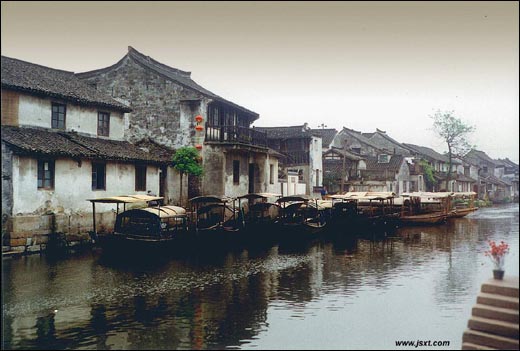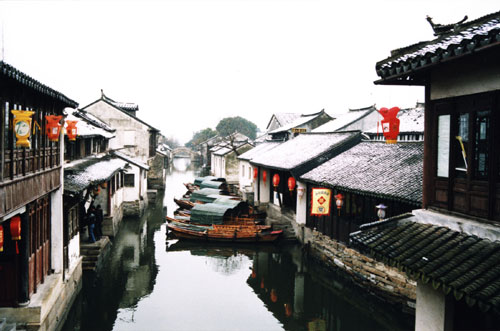CONTACT US
| +86-10-82600771 | |
| WhatsApp: +86-13911460247 | |
| Messenger: chinatournet | |
WeChat ID: callchinatour | |
Zhouzhuang lies at the middle between Shanghai and Suzhou, is an ancient town of Kunshan City, Jiangsu Province, where abounds with rivers and lakes. So it is thought by many to be the best waterside town in China.This ancient town has a history of more than 900 years old with many houses built in the Ming and Qing Dynasties. There are about 100 houses with courtyards, and 60 of them have arch gateways made by carved bricks.
With lakes on four sides, the beauty of Zhouzhuang is specially to be found along the waterside lanes and around a number of the stone bridges. A different vista at every turn can be found here. All those make a visit most enjoyable. Also, one can enjoy the fairyland atmosphere of the evenings here when the myriad stars twinkle as though in communication with the glittering lights.
Zhou Zhuang's Attraction
Waterlanes & Stone bridges
The layout of the water lanes in Zhouzhuang is perfectly arranged so that it looks like the Chinese character “#â€. Many stone bridges are built over them, linking up the households on both sides of every stream. These stone bridges are very old, 14 of which were built respectively in the Yuan, Ming and Qing Dynasties. The most representative among them are the Twin Bridges, Fu’an Bridge, Zhenfeng Bridge and Fuhong Bridge, etc… A beautiful saying is very popular among the folks in China-“The Heavens have their Paradise while the earth is proud of having Suzhou and Hangzhouâ€. Zhouzhuang is just like a water lily in-between.
The Twin Bridge

It consists of the Shide and Yong’an Bridge built between 1573 and 1619, and is situated to the northeast of the town.
The area is crossed by the Yinzi and Nanbei rivers, and the bridges are built in one in the direction of north-south and the other east-west, with one square and one round opening. Because they look like an ancient key, it also known as Key Bridge. Chen Yifei, a young artist residing in the U.S. created a picture of “Memories of Hometown†based on the Double Bridge in 1984. The painting, with Chen’s other 37 works, were exhibited and bought by Dr. Armond Hammer, an American oil tycoon, and later presented to the late Deng Xiaoping. The painting symbolizes the friendship, cooperation and peace between the two countries. In 1985, the painting was used on a first day cover issued by the UN, so that more and more people come to know Zhouzhuang’s beautiful scenery.
Fu’an Bridge

Fu’an Bridge is located at the east end of Zhongshi Street, crossing the Nanbeishi River and leading to the Nanbeishi Street.
It was built in 1355, and rebuilt by Shen Wansi, younger brother of Shen Wansan. It has towers on all four corners. Each side has carved beams and painted rafters. People can now enjoy local foods and shopping in the towers.
Zhenfeng Bridge

Zhenfeng Bridge is sitting on the west mouth of Zhongshi River, and connects the Zhenfeng Lane and Xiwan Street. It was rebuilt in the Ming and Qing Dynasties, and is well-preserved today.
Heritages of the Ming and Qing Dynasties

Zhouzhuang has about 1000 households who are living in the old dwelling quarters. More than 60% of the houses built in the Ming and Qing dynasties and the early Republic of China as well are well preserved. Among which there are 100 houses with each having a courtyard and 60 of them have an arch gateway for each made by carved bricks. The houses of both Zhang and Shen families remain intact and are rated as the best heritages among all of them for their ancient style.
Shen’s House

Shen’s House is located to the southeast of Fu’an Bridge, on Nanshi Street. It was built in 1742 during the Qing Dynasty by Shen Benren, a descendant of Shen Wanshen who was a man of wealth in southern China in the late Yuan (1206-1368) to early Ming Dynasties.
It consists of seven courtyards, five archways, more than 100 rooms of different size along two sides of a 100-m-long axis road, covering an area of 2000 sq.m, offering a unique traditional Chinese architectural style.
It has three sections. The first includes the water gate and wharf for mooring boats and washing. The second one consists of the Tea Hall and Main Hall for receiving guests and holding wedding or funeral ceremonies. The rear part serves as living quarters.
The Main Hall covers 170 sq.m. The 6-m-high carved brick archway, facing the Main Hall, is the most magnificent among the five, with a horizontal inscribed board bearing the inscription, Jihouliuguang ( do more good for ever). Around the board are relief sculptures of figurines, animals, pavilions and opera characters.
Zhang’s House
Zhang’s House is located at the south of the Twin Bridge on Beishi Street. Built between 1436 and 1449 by the offspring of Xu Kui, the brother of Zhongshan King Xu Da, it was sold to Zhang’s family in the early Qing Dynasty, after which it was called either Yuyan (Jade Swallow) Hall or Zhang’s House.
It has 6 courtyards and more than 70 rooms, covering more than 1800 sq.m. The first courtyard has side buildings on the east and west, with long and short windows. Yuyan Hall is the main building, large and bright with grand column on big nanmu pier bases, a rare Ming style. A river flows under the hall, with a square pool built in the middle section to allow boats to turn round. Its rear hall has open windows and balconies facing the water with a backyard of various plants and flowers.
The place now is an important cultural relic under protection of the provincial government.
Ye Chucang Residence

Ye Chucang (1887-1946), born in Zhouzhuang, was a poet of the South Society and a statesman, and was graduated from Suzhou High School. When he came home during winter vocation, he saw many people involving in gambling and opium, so he organized a group of young people to publicize the harm of these activities.
His residence, Zuyin Hall, located on Xiwan Street facing north, was built in the Qing Dynasty, consisting of five courtyards. The Main Hall is a studio and the Rear Hall is a place where Ye received friends.